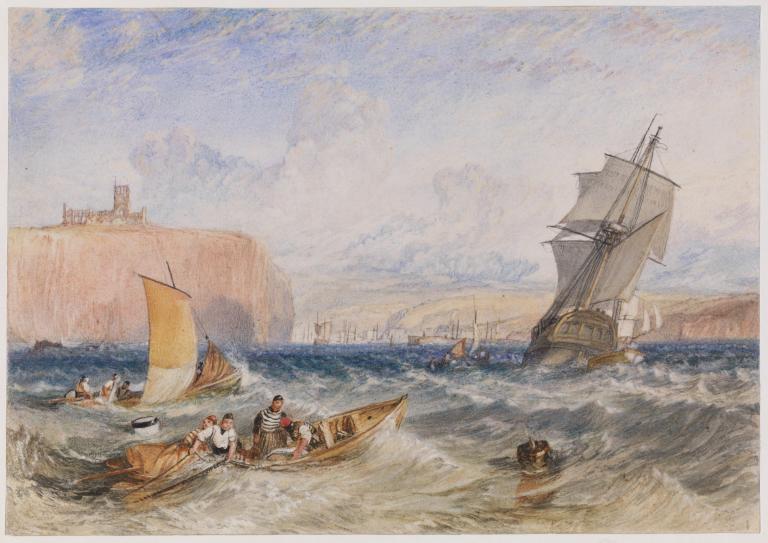Joseph Mallord William Turner Whitby c.1824
Joseph Mallord William Turner,
Whitby
c.1824
Joseph Mallord William Turner 1775–1851
Whitby c.1824
D18143
Turner Bequest CCVIII J
Turner Bequest CCVIII J
Watercolour on white wove watercolour paper, 158 x 225 mm
Blind-stamped with Turner Bequest monogram bottom right
Blind-stamped with Turner Bequest monogram bottom right
Accepted by the nation as part of the Turner Bequest 1856
Exhibition history
1904
National Gallery, London, various dates to at least 1904 (170).
1934
Display of Watercolours from the Turner Bequest, Tate Gallery, London, March 1934–May 1937 (no catalogue).
1980
Turner in Yorkshire, York City Art Gallery, June–July 1980 (141).
1993
J.M.W. Turner 1775–1851: Impressions de Gran Bretanya i el Continent Europeu / Impresiones de Gran Bretaña y el Continente Europeo, Centre Cultural de la Fundació ”la Caixa”, Barcelona, September–November 1993, Sala de Exposiciones de la Fundación ”la Caixa”, Madrid, November 1993–January 1994 (36, reproduced in colour).
1994
J.M.W. Turner 1775 – 1851: Aquarelles et Dessins du Legs Turner: Collection de la Tate Gallery, Londres/Watercolours and Drawings from the Turner Bequest: Collection from the Tate Gallery, London, Palais des Beaux-Arts de Charleroi, September–December 1994 (36, reproduced in colour).
2002
Turner: Reflections of Sea and Light: Paintings and Watercolours by J.M.W. Turner from Tate, Baltimore Museum of Art, February–May 2002 (no catalogue).
2002
Turner y el mar: Acuarelas de la Tate, Fundación Juan March, Madrid, September 2002–January 2003 (18, reproduced in colour).
2003
O Mar e a Luz: Aguarelas de Turner na colecção da Tate, Museu Calouste Gulbenkian, Lisbon, Februray–May 2003 (19, reproduced in colour).
References
1904
E.T. Cook and Alexander Wedderburn (eds.), Library Edition: The Works of John Ruskin: Volume XIII: Turner: The Harbours of England; Catalogues and Notes, London 1904, pp.69–70; 615, no.170, as ‘Whitby’.
1909
A.J. Finberg, A Complete Inventory of the Drawings of the Turner Bequest, London 1909, vol.II, p.629, CCVIII J, as ‘Whitby’.
1979
Andrew Wilton, J.M.W. Turner: His Life and Work, Fribourg 1979, p.387, no.752.
1990
Eric Shanes, Turner’s England 1810–38, London 1990, p.131, no.103 (colour).
1994
Ian Warrell, J.M.W. Turner 1775 – 1851: Aquarelles et Dessins du Legs Turner: Collection de la Tate Gallery, Londres/Watercolours and Drawings from the Turner Bequest: Collection from the Tate Gallery, London, exhibition catalogue, Palais des Beaux-Arts de Charleroi 1994, pp.32–3; no.36, reproduced in colour.
1996
Julius Bryant, Turner: Painting the Nation: English Heritage Properties as Seen by J.M.W. Turner, London 1996, pp.78–9, reproduced in colour.
‘As an expression of the general spirit of English coast scenery’ Turner’s Whitby ‘must be considered the principal one of the series’, writes John Ruskin.1 The view is based on very slight sketches dating from 1822, when Turner travelled to Edinburgh in order to witness the celebrations of the recently crowned George IV (see the King’s Visit to Edinburgh sketchbook: Tate D17515, D17655–D17656, D17662; Turner Bequest CC 4a, 83a, 84, 87).
Ian Warrell writes that ‘in focussing on the fishermen pulling in their nets Turner emphasises the daily heroism involved in their dangerous trade’.2 Ruskin also notes that the ‘exaggerations of space and size’ in this drawing are ‘allowable’ given that these proportions help to ‘convey the feeling of danger conquered by activity and commerce, which characterises all our northerly Eastern coast’.3 The sharp diagonal sway of the ship certainly makes manifest the power of the sea and its strength of its currents. Julius Bryant suggests that fishermen hauling in their catch may also be intended to ‘double as the traditional Christian metaphor’, particularly as the linear ‘Y’ shape of the coble’s lug and mast lead the eye towards the abbey.4
The ruin of the Benedictine monastery on the headland remains to this day a distinctive feature of the town. It is here rendered with yellow and pink wash, applied in layered strokes to suggest the warm luminosity of the morning sun. In Turner’s drawing it stands isolate and exposed atop cliffs rendered with a ‘monotonous and severe verticality’, according to Ruskin.5 Founded by St Hilda in 657, the abbey was the location for the Synod of 664 when nuns and monks sought to reconcile the Celtic and Roman branches of the Christian church. The Benedictine abbey was built on these foundations in the thirteenth and fourteenth centuries but was destroyed by Henry VIII during the dissolution.
The verso of this drawing (Tate D41483; Turner Bequest CCVIII Jv) has been painted with grey watercolour wash of varying saturations.
This drawing was engraved in mezzotint by Thomas Lupton and published in 1826 (Tate impressions T04825–T04827).
Alice Rylance-Watson
March 2013
How to cite
Alice Rylance-Watson, ‘Whitby c.1824 by Joseph Mallord William Turner’, catalogue entry, March 2013, in David Blayney Brown (ed.), J.M.W. Turner: Sketchbooks, Drawings and Watercolours, Tate Research Publication, September 2014, https://www

